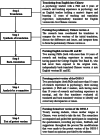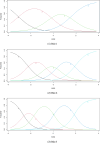Validation of the Chinese version of the Oslo-3 Social Support Scale among nursing students: a study based on Classical Test Theory and Item Response Theory models
- PMID: 38816705
- PMCID: PMC11137908
- DOI: 10.1186/s12912-024-02033-5
Validation of the Chinese version of the Oslo-3 Social Support Scale among nursing students: a study based on Classical Test Theory and Item Response Theory models
Abstract
Background: Nursing students are encountering a range of health issues. Assessing social support is a key component in most questionnaire surveys related to health status, aiming to investigate the relationships and mechanisms between health status and social support to enhance overall health. Therefore, it is essential to seek out appropriate instruments to evaluate social support for nursing students. The Oslo-3 Social Support Scale (OSSS-3) is a reliable and concise instrument for evaluating social support. To date, there have been no studies validating the OSSS-3 based on Item Response Theory (IRT) models. Also, an officially validated Chinese version has not been found. The current research intended to verify the Chinese version of the OSSS-3.
Methods: The OSSS-3 was translated into Chinese and culturally adapted. Subsequently, the OSSS-3 was validated by employing the Classical Test Theory (CTT) and IRT models.
Results: The split-half reliability was 0.622. The Cronbach's α coefficient was 0.687. The correlations between each item and total scores varied from 0.723 to 0.835. The retest coefficient was 0.907. The content validity index was 0.933. A single common factor was extracted and accounted for 61.559% of the variance. The item loading values on the single factor were between 0.743 and 0.814. The communalities were between 0.552 and 0.663. There was no variance between males and females (P = 0.055). The difference in scores between the top (30%) and bottom (30%) groups attained significance. IRT models results revealed that the discrimination parameters ranged from 1.39 to 2.33 and difficulty parameters increased monotonically.
Conclusion: The OSSS-3 demonstrates satisfying psychometric properties and is a proper instrument for measuring social support in Chinese nursing students.
Keywords: Difficulty; Discrimination; Reliability; Social support; Validity.
© 2024. The Author(s).
Conflict of interest statement
The authors declare no competing interests.
Figures
Similar articles
-
Psychometric properties of the Coronavirus Anxiety Scale based on Classical Test Theory (CTT) and Item Response Theory (IRT) models among Chinese front-line healthcare workers.BMC Psychol. 2023 Aug 7;11(1):224. doi: 10.1186/s40359-023-01251-x. BMC Psychol. 2023. PMID: 37550697 Free PMC article.
-
[Study on the applicability of the Brief Job Stress Questionnaire based on classical test theory and item response theory].Zhonghua Lao Dong Wei Sheng Zhi Ye Bing Za Zhi. 2024 May 20;42(5):321-331. doi: 10.3760/cma.j.cn121094-20231206-00144. Zhonghua Lao Dong Wei Sheng Zhi Ye Bing Za Zhi. 2024. PMID: 38802304 Chinese.
-
Validation of a Chinese Version of the Digital Stress Scale and Development of a Short Form Based on Item Response Theory Among Chinese College Students.Psychol Res Behav Manag. 2023 Jul 31;16:2897-2911. doi: 10.2147/PRBM.S413162. eCollection 2023. Psychol Res Behav Manag. 2023. PMID: 37547623 Free PMC article.
-
Psychometric Evaluation of the Chinese Version of the Mental Health System Responsiveness Questionnaire for Psychiatric Outpatients: Classical Test Theory and Item Response Theory Approaches.Patient Prefer Adherence. 2025 Mar 24;19:729-740. doi: 10.2147/PPA.S503016. eCollection 2025. Patient Prefer Adherence. 2025. PMID: 40162159 Free PMC article.
-
Psychometric Testing of the Chinese Simple Version of the Simulation Learning Effectiveness Inventory: Classical Theory Test and Item Response Theory.Front Psychol. 2020 Feb 19;11:32. doi: 10.3389/fpsyg.2020.00032. eCollection 2020. Front Psychol. 2020. PMID: 32140119 Free PMC article.
References
-
- Drageset J. Social support. In: Haugan G, Eriksson M, editors. Health promotion in health care-vital theories and research. Cham (CH): Springer; 2021. - PubMed
-
- Casapulla S, Rodriguez J, Nandyal S, Chavan B. Toward resilience: medical students’ perception of social support. J Am Osteopath Assoc. 2020;120(12):844–854. - PubMed
Grants and funding
LinkOut - more resources
Full Text Sources





